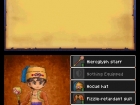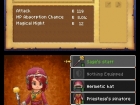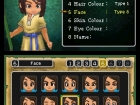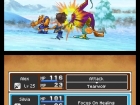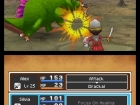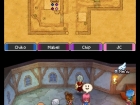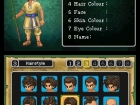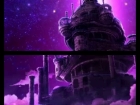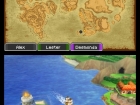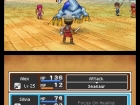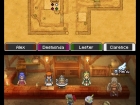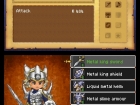 Even though both originators of the JRPG just happened to had major sequels released a few months apart; it’s interesting to see just how far apart the two series have diverged during the past twenty years. While Final Fantasy 13 has all but abandoned its 8/16-bit past – transforming itself into one big interactive anime — Dragon Quest 9 has gone the opposite path: forgoing lush, HD graphics and an epic story in lieu of a relatively simple tale housed in a simple system graphically (Nintendo DS), complimented with a ton of side-quests, item hording and sadly, an ad-hoc local multiplayer feature than many people won’t get a chance to use much.
Even though both originators of the JRPG just happened to had major sequels released a few months apart; it’s interesting to see just how far apart the two series have diverged during the past twenty years. While Final Fantasy 13 has all but abandoned its 8/16-bit past – transforming itself into one big interactive anime — Dragon Quest 9 has gone the opposite path: forgoing lush, HD graphics and an epic story in lieu of a relatively simple tale housed in a simple system graphically (Nintendo DS), complimented with a ton of side-quests, item hording and sadly, an ad-hoc local multiplayer feature than many people won’t get a chance to use much.
After creating your character (you can be a male or female) you start the story as a Celestrian, a being whose home is on the Observatory: a floating kingdom that kind-of acts like as a midway point between earth and heaven. A Celestrian’s goal is to move on to Gods Land; in order to do that, each Celestrian must protect and help the people living in the mortal realm. As a reward, the people – who can neither see nor hear you — will give thanks which manifest itself into benevolessence. The Celestrians then take that benevolessence to the Yggdrasil (The World Tree). The hope being that the tree will eventually grow a rare and powerful fruit called the fygg, which will allow you and your kin to finally travel to heaven.
After spending an hour-or-so helping the people of your appointed town called Angel Falls, you eventually gain enough benevolessence for the Yggdrasil tree to finally grow the powerful fruit. Unfortunately, things take an expected turn, as the tree is struck by a mysterious force, which causes you and the fruit to fall onto earth. While you survive, you find that you lost your halo and wings in the fall, which allows the people on earth to see you, while being oblivious to your real identity. With the help of sassy fairy named Stella, you eventually make it back to the Observatory, only to be sent back to recover the lost fyggs.
While the plot starts out as original, it never goes above anything you’ve already seen in past 16-bit JRPGS. You discover that random people eventually stumble on to the fruit, which grants them their wishes, only in a twisted way. For example one old man wishes that he could turn back in time so that he can rekindle a lost love form long ago. Once he eats the fruit though, a magical beast emerges and protects the stone recreation of a town that the old man sculpted. Once you defeat the beast, you’ll regain the fruit.
While simple and not exactly groundbreaking, there’s a certain charm to the simplicity of the rest of the games story. There isn’t any real grand plot twists and turns that go on-and-on. In fact, the games plot seems to have been designed for people to pick up the DS, spend 30-minutes to grind, close the system, and spend another 30-45 minutes to finish a particular quest.
The biggest problem story-wise is that since Dragon Quest 9 was designed as a mostly multiplayer game, your team members are, for all intents and purposes, completely lifeless. After a couple hours, you can recruit four additional party members with different classes (Priest, Mage, Warrior, Ninja, etc…). You can also create your own teammate. Unfortunately, there is literally no interaction between you and your teammates or your teammates and the rest of the world. The only person in your party who has any resemblance of personality is Sally, and she’s only used as a glorified record keeper. While I can see the practicality of lobotomizing your teammates – so that other players can seamlessly jump into your game in ad-hoc multiplayer – it does make the game a little bland if all you’re interested is the singleplayer.
Speaking of multiplayer, a big opportunity was missed by not making this game online multiplayer enabled. While you can obviously play ad-hoc multiplayer, the reality is that most people in the US who buy Dragon Quest 9 will never get the chance to take advantage of joining other games and sharing items. The only reason I see Dragon Quest 9 being a practical multiplayer endeavor is if you and a friend plan on buying copies of the same game. While the ad-hoc multiplayer feature may work brilliantly in Japan, in the sprawling North America, the ad-hoc features will at best, be a curious novelty and at worse, be ignored completely.
One online feature that will be used a lot is the DQ VC. The DQ VC allows you to connect online to an online shopping service to download retrieve special rare items and quests. Thankfully, no real currency is required. The store is constantly updated and if used right, can dramatically increase the replay value of the game.
For those of you only interested in singleplayer, you’ll be happy to know that the game has hours and hours of extra content outside of the main plot. You’ll meet up with many random people who have specific quests that they need you to complete. They range from getting a specific item to doing a specific act in battle; the difficulty ranging from simple to frustrating. In addition there are tons of items, weapons and armor to collect. Another way to get rare items is to alchemize items together into better items/weapons/armor. You can either try your luck or get recopies by reading certain bookshelves in the game. While it may not sound too exciting on the surface, the addictive nature collecting rare items and doing quests can quickly turn a 35-hour adventure into a 60-hour one.
In terms of gameplay, one major change from past adventures is the ability to use your DS stylus to move your character on the screen. While you can use the D-pad, I found using the stylus to be a big improvement. You can also use your stylus to select commands during battle as well; but in the later case, I found it much quicker to just use the buttons and the D-pad to quickly select your option.
Other than the touch screen, the battles play pretty much the same as past Dragon Quest games. One change is that there are no more random battles. You can finally see where the enemies are in the overhead map; though they do get tricky and spawn in narrow passages on occasion, essentially blocking your path in certain circumstances. One slightly annoying thing about enemy encounters is that if you need to use an item or heal, the enemies continue to move around on the screen. Often time, I would go to the menu to heal my character, only to find that a monster spawned right in front of me as soon as I closed the window.
Graphically, they did an admirable job of keeping the graphics as current as possible, considering the hardware it runs on. Still, you notice a bunch of blocky sections (noticeably the hands) as well as a lot of grainy textures. Still, for the DS, the graphics are fantastic. Those of you who played the last game on the PS2 however may find it a little harder to adjust to the downgrade.
Overall, Dragon Quest 9 is easily one of the best gaming values for either the handheld or consoles. While there is a major missed opportunity when it comes to the multiplayer (lack of online), especially considering focus on multiplayer arguably hurt aspects of the singleplayer, (mainly the lifeless party members). Thankfully the character customization, the charming story, online store and tons of additional quests make up the games couple of noticeable shortcomings. If you are looking for a long-term adventure with a charming 16-bit-style that you can play in hour-or-so bursts, then Dragon Quest 9 is right up your ally.
Gameplay
Graphics
Sound
Overall
Buy Dragon Quest IX: Sentinels of the Starry Skies from EBGames.com directly from our site.

Buy from EBgames.com right now!

